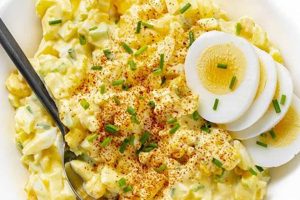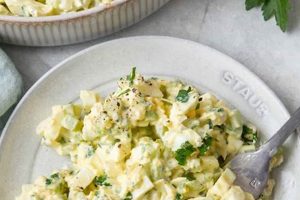A combination of chopped hard-boiled eggs, mayonnaise, and seasonings, often including mustard, celery, onion, salt, and pepper, creates a creamy filling ideal for bread, croissants, or crackers. Variations can incorporate ingredients like relish, paprika, or fresh herbs.
This classic dish offers a convenient and protein-rich meal option, suitable for quick lunches, picnics, or potlucks. Its adaptability allows for customization based on dietary preferences and ingredient availability, contributing to its enduring popularity. Historically, chopped egg dishes have been enjoyed for centuries, with documented recipes appearing as early as the 18th century. The evolution of mayonnaise as a binding agent further solidified the modern iteration of this dish as a staple in many cultures.
The following sections will explore specific ingredient choices, detailed preparation instructions, and creative serving suggestions to elevate this simple yet satisfying culinary creation.
Tips for Exceptional Egg Salad
Achieving optimal flavor and texture requires attention to detail throughout the preparation process. The following tips offer guidance for crafting superior egg salad.
Tip 1: Perfect Hard-Boiled Eggs: Avoid overcooking eggs, which can result in a dry, rubbery texture and a green ring around the yolk. Start with cold eggs, bring water to a rolling boil, then remove from heat and let sit covered for 9-12 minutes depending on desired yolk consistency. Immediately transfer to an ice bath to halt cooking.
Tip 2: Precise Chopping: Uniformly chopped eggs ensure even distribution of flavor and a pleasing texture. A sharp knife or an egg slicer facilitates clean cuts and prevents crumbling.
Tip 3: Mayonnaise Mastery: The quality and quantity of mayonnaise significantly impact the final product. Start with a small amount and add incrementally until the desired creaminess is achieved. Experiment with different types of mayonnaise for flavor variations.
Tip 4: Seasoning Strategies: Salt and freshly ground black pepper are essential seasonings. A touch of Dijon mustard adds complexity, while paprika provides a subtle smoky note. Taste and adjust seasonings throughout the mixing process.
Tip 5: Texture Enhancement: Finely diced celery and red onion add a pleasant crunch and subtle flavor. Consider incorporating other textural elements like chopped pickles or water chestnuts.
Tip 6: Fresh Herb Infusion: Fresh herbs, such as dill, chives, or parsley, elevate the flavor profile. Add chopped herbs just before serving to maximize their aromatic impact.
Tip 7: Proper Chilling: Allowing the egg salad to chill for at least 30 minutes in the refrigerator allows flavors to meld and enhances the overall experience.
By adhering to these guidelines, one can consistently create egg salad that is both flavorful and visually appealing. These techniques ensure a delightful culinary experience, whether enjoyed as a simple sandwich filling or a more elaborate appetizer.
The following section provides a complete recipe incorporating these tips for a truly exceptional egg salad.
1. Ingredient Quality
Ingredient quality significantly impacts the final flavor and texture of egg salad. Fresh, high-quality eggs contribute a richer, cleaner taste compared to older eggs, which can impart a slightly sulfuric flavor. Likewise, using high-quality mayonnaise, preferably made with real eggs and oil, elevates the overall richness and creaminess of the salad. Freshly ground spices, such as black pepper, offer a more vibrant and complex flavor profile than pre-ground alternatives. For example, using farm-fresh eggs, as opposed to store-bought eggs that may be several weeks old, results in a noticeably improved taste and texture. Opting for a stone-ground mustard over a generic yellow mustard provides a deeper, more nuanced flavor dimension.
The impact of ingredient quality extends beyond flavor. Fresh produce, such as crisp celery and onion, contributes a desirable crunch and bright flavor, while wilted or older produce can detract from the overall sensory experience. Using quality ingredients also influences food safety. Fresh, properly handled ingredients minimize the risk of bacterial contamination, ensuring a safe and enjoyable meal. For instance, incorporating fresh, properly washed herbs, rather than dried or older herbs, not only elevates the flavor profile but also reduces potential health risks associated with spoiled ingredients.
Ultimately, prioritizing ingredient quality results in a superior egg salad. The difference between using fresh, high-quality ingredients and using subpar alternatives is discernible in both taste and texture. While cost considerations sometimes influence ingredient selection, understanding the significant impact of quality on the final product emphasizes the value of investing in superior components whenever feasible. This investment translates to a more flavorful, enjoyable, and safer culinary experience.
2. Precise Preparation
Precise preparation techniques are crucial for achieving optimal texture, flavor, and overall quality in egg salad. From cooking the eggs to chopping ingredients and combining them, each step requires attention to detail. These precise methods ensure a consistent and enjoyable final product.
- Egg Cooking Time:
Properly cooked eggs are essential for a desirable texture. Overcooked eggs become rubbery and dry, while undercooked eggs can be unsafe to consume. A precise cooking time, typically 9-12 minutes for hard-boiled eggs, yields a firm yet tender yolk and prevents the formation of a green ring around the yolk. This precise timing ensures a pleasant texture and maximizes flavor.
- Chopping Consistency:
Uniformly chopped ingredients contribute to a visually appealing and texturally satisfying egg salad. Unevenly chopped pieces create an inconsistent texture and can affect flavor distribution. Precise chopping ensures that all ingredients blend harmoniously and contribute equally to the overall taste and mouthfeel. For example, consistently chopped eggs and finely diced celery create a balanced and pleasant texture.
- Ingredient Incorporation:
The method of incorporating ingredients impacts both flavor and texture. Gently folding in ingredients, rather than aggressively mixing, prevents the eggs from becoming overly mashed and maintains a desirable texture. This careful approach also ensures even distribution of seasonings and other ingredients throughout the salad, maximizing flavor development.
- Chilling Time:
Chilling the prepared egg salad allows the flavors to meld and develop fully. This chilling period also firms the salad, making it easier to spread on bread or crackers. A sufficient chilling time, ideally at least 30 minutes, ensures a more cohesive and flavorful final product.
These precise preparation techniques, while seemingly minor, contribute significantly to the overall quality of the egg salad. Attention to detail in each step, from egg cooking to chilling time, ensures a consistently delicious and enjoyable sandwich filling. The combination of properly cooked eggs, uniformly chopped ingredients, gentle incorporation, and adequate chilling time results in an egg salad that is both flavorful and texturally pleasing.
3. Flavor Balancing
Flavor balancing is paramount in crafting exceptional egg salad. The interplay of savory, acidic, and textural components determines the overall palatability. A harmonious balance prevents any single flavor from dominating, creating a nuanced and enjoyable culinary experience. Consider the delicate balance between the richness of mayonnaise and the sharpness of mustard. Too much mayonnaise can result in a bland, overly rich salad, while excessive mustard creates an overpowering pungency. The judicious use of both, however, allows each element to complement the other, enhancing the overall flavor profile. Similarly, the addition of acidic elements like vinegar or lemon juice brightens the flavor and cuts through the richness of the mayonnaise, preventing the salad from becoming heavy or cloying. Adding a pinch of salt enhances the inherent flavors of the eggs and other ingredients, while a touch of sweetness, perhaps from a finely diced sweet pickle relish, adds another layer of complexity.
The interplay of flavors extends beyond the core ingredients. The inclusion of aromatics, such as finely chopped red onion or chives, contributes a subtle sharpness and depth of flavor. Spices, like paprika or cayenne pepper, introduce warmth and complexity, while fresh herbs, such as dill or parsley, provide a refreshing counterpoint to the richness of the base. Textural elements, such as chopped celery or water chestnuts, also play a role in flavor balancing, adding a contrasting crunch that complements the creamy texture of the egg salad. These textural variations stimulate the palate and enhance the overall sensory experience. For instance, the subtle bitterness of celery complements the richness of the yolks and the tanginess of the dressing, creating a balanced and multi-dimensional flavor profile.
Achieving optimal flavor balance often involves a degree of experimentation and adjustment. Taste testing throughout the preparation process is crucial. This allows for incremental additions of seasonings and ingredients, ensuring that the final product achieves the desired harmony of flavors. Understanding the interplay of different flavor components enables informed decision-making regarding ingredient selection and proportions. This, in turn, empowers one to create egg salad that transcends mere sustenance, offering a nuanced and genuinely enjoyable culinary experience. The delicate balance of flavors transforms simple ingredients into a cohesive and satisfying dish.
4. Texture Considerations
Texture plays a crucial role in the overall enjoyment of egg salad sandwiches. The interplay of creamy, crunchy, and smooth elements contributes significantly to the sensory experience. Careful consideration of textural components elevates egg salad from a simple mixture to a more complex and satisfying dish. Understanding how different ingredients and preparation methods contribute to texture allows for greater control over the final product.
- Egg Consistency:
The texture of the eggs themselves forms the foundation of the egg salad’s texture. Overcooked eggs become dry and crumbly, resulting in a less desirable mouthfeel. Properly cooked eggs, on the other hand, offer a tender, yet firm consistency that provides a pleasant backdrop for other textural elements. Achieving this ideal egg consistency requires precise cooking times and immediate cooling to prevent overcooking.
- Chopping Technique:
The size and uniformity of the chopped ingredients significantly impact the overall texture. Roughly chopped ingredients create a more rustic texture, while finely diced ingredients yield a smoother, more refined mouthfeel. The choice of chopping technique depends on personal preference and the desired final texture. For example, finely diced celery and onion provide a subtle crunch without overwhelming the creamy base, while coarsely chopped ingredients offer a more pronounced textural contrast.
- Added Crunch:
Incorporating crunchy elements provides textural variety and enhances the eating experience. Ingredients like finely diced celery, red onion, or chopped pickles introduce a contrasting crispness that complements the creamy texture of the egg mixture. Other options for added crunch include chopped water chestnuts, toasted nuts, or croutons. The choice of crunchy element depends on the desired flavor profile and the overall balance of textures.
- Bread Choice:
The texture of the bread itself contributes to the overall sensory experience. Soft, fluffy bread offers a gentle contrast to the creamy filling, while crusty bread provides a more substantial textural counterpoint. The choice of bread also influences how the sandwich holds together and how the flavors meld. For instance, a croissant’s flaky layers offer a unique textural experience compared to a classic white bread slice.
By carefully considering these textural elements, one can create egg salad sandwiches that offer a more complex and satisfying sensory experience. The interplay of creamy, crunchy, and smooth textures elevates the dish beyond a simple combination of ingredients. This attention to texture transforms egg salad from a basic meal into a more nuanced and enjoyable culinary creation. The thoughtful combination of textural elements ultimately determines the overall success and enjoyment of the sandwich.
5. Proper Storage
Proper storage is crucial for maintaining the safety and quality of egg salad sandwiches. Due to the perishable nature of eggs and mayonnaise, improper storage can lead to bacterial growth and spoilage, posing significant health risks. Refrigeration at temperatures below 40F (4C) inhibits bacterial proliferation and preserves the freshness of the ingredients. Storing the egg salad in an airtight container prevents contamination from other foods and minimizes oxidation, which can affect flavor and texture. For example, leaving egg salad at room temperature for an extended period, particularly in warm environments, can create ideal conditions for harmful bacteria like Salmonella to multiply, leading to foodborne illness. Conversely, prompt refrigeration after preparation significantly reduces this risk.
The shelf life of egg salad, even under proper refrigeration, is limited. Generally, egg salad should be consumed within three to five days of preparation. Beyond this timeframe, the risk of bacterial growth increases significantly, even under refrigeration. Freezing egg salad is not recommended, as the mayonnaise-based dressing separates upon thawing, resulting in an undesirable texture. Practical applications of proper storage include using shallow containers for faster cooling in the refrigerator and labeling containers with preparation dates to ensure timely consumption. These practices minimize food waste and maximize food safety.
Effective storage practices are essential for ensuring the safety and enjoyment of egg salad sandwiches. Refrigeration at appropriate temperatures, use of airtight containers, and adherence to recommended shelf-life guidelines minimize the risk of foodborne illness and preserve the quality of the dish. Diligence in these practices ensures a safe and satisfying culinary experience. Failure to observe these storage guidelines can have detrimental effects on both the quality of the sandwich and the health of the consumer, highlighting the crucial connection between proper storage and the overall success of an egg salad recipe.
Frequently Asked Questions
This section addresses common inquiries regarding egg salad preparation and storage, offering practical guidance for optimal results and food safety.
Question 1: How long can egg salad be safely stored in the refrigerator?
Refrigerated egg salad should be consumed within three to five days to minimize the risk of bacterial growth.
Question 2: Can egg salad be frozen?
Freezing is not recommended. The mayonnaise-based dressing separates upon thawing, resulting in an undesirable texture.
Question 3: What are signs that egg salad has spoiled?
Indicators of spoilage include a sour odor, discoloration, or a slimy texture. Discard immediately if any of these signs are present.
Question 4: How can one prevent the yolks from becoming dry and crumbly?
Avoid overcooking the eggs. A cooking time of 9-12 minutes, followed by immediate immersion in an ice bath, typically yields a tender yolk.
Question 5: What are some alternatives to mayonnaise in egg salad?
Plain Greek yogurt, mashed avocado, or a combination of olive oil and lemon juice can serve as healthier alternatives to mayonnaise.
Question 6: How can one enhance the flavor of egg salad beyond basic seasonings?
Incorporating ingredients like fresh herbs, Dijon mustard, chopped pickles, or hot sauce can add depth and complexity to the flavor profile.
Adhering to safe food handling practices and utilizing these guidelines contributes to a more enjoyable and safer culinary experience.
The following section provides a collection of recipe variations for those seeking to explore different flavor profiles and ingredient combinations.
Egg Salad Recipe for Sandwiches
This exploration of egg salad recipes for sandwiches has delved into the nuances of ingredient selection, precise preparation techniques, flavor balancing, textural considerations, and proper storage. High-quality ingredients, coupled with precise cooking and chopping methods, form the foundation of a superior egg salad. Balancing flavors through the judicious use of seasonings and complementary ingredients elevates the dish beyond basic sustenance. Attention to textural elements, from the consistency of the eggs to the addition of crunchy components, enhances the sensory experience. Finally, proper storage practices ensure food safety and preserve the quality of this versatile dish.
Egg salad, often perceived as a simple dish, offers a canvas for culinary creativity. Understanding the interplay of these key elements allows for endless variations and personalized adaptations. Whether enjoyed as a quick lunch, a picnic staple, or a sophisticated appetizer, egg salad remains a testament to the transformative power of culinary technique applied to even the most humble ingredients. Its enduring popularity reflects not only its versatility and ease of preparation but also its capacity to satisfy a fundamental human need for flavorful, nourishing food. Continued exploration of ingredient combinations and flavor profiles promises to further enrich the culinary landscape and solidify the egg salad sandwich’s place as a timeless classic.






